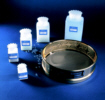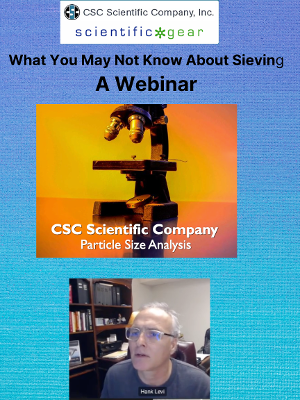Sieve Calibration Microspheres
Sieving
Sieving is sometimes referred to as "the Cinderella of the particle-size analysis" because it performs most of the work but gets little of the credit.
New high-tech processes of Sedimentation, Laser Diffraction and Image Analysis get most of the headlines. Issues affecting the universal implementation of these methods vs. sieving are high instrument cost, calibration, extensive operator training and procedural discipline.
Sieving has occasionally received a bad name because tests are sometimes performed with subpar sieve mesh. Consequently, much has been made of obtaining sieves certified via ASTM or ISO mesh standards.
Sieve Certification
Optical approaches can accomplish this, either with a microscope or video image analysis. Results are presented  in terms of maximum and minimum aperture size on the warp and on the weft, largest admissible openings and average openings. The number of openings measured is specified, means are calculated and a report is then generated.
in terms of maximum and minimum aperture size on the warp and on the weft, largest admissible openings and average openings. The number of openings measured is specified, means are calculated and a report is then generated.
The prescribed optical certification methods examine only a small number of the openings--usually less than 1%. For example, a 63 micron sieve has 2.5 million apertures; the ASTM method requires examination of less than 1000 apertures. Opening size tolerances can exceed 10%. A 63 micron sieve has allowable tolerances of 12 microns or almost 20%.
Thus, a certification report can be viewed as only an insurance policy - assurance that a sieve's mesh is within a required specification. It is not a valuable predictor of a sieve's performance.
Sieve Calibration
In some circles, the development of microspheres with tolerances as tight as +/- 0.5 microns in diameter has started a revolution in thinking about sieve certification and calibration.
Certification and re-certification are expensive and laborious processes, requiring special equipment and technician patience. It should be emphasized that the end result is no more than an  insurance policy and is not a true predictor of a sieve's performance. Microsphere calibration standards, however, bring the promise of not only the insurance policy (that sieve calibrations are traceable), but also produce specific numerical results that predict performance of a test sieve.
insurance policy and is not a true predictor of a sieve's performance. Microsphere calibration standards, however, bring the promise of not only the insurance policy (that sieve calibrations are traceable), but also produce specific numerical results that predict performance of a test sieve.
Calibrated Microspheres
Calibrations utilizing Whitehouse Scientific Calibrated Microspheres yield highly accurate sieve performance predictors. The method is simple and results are traceable to NIST. The process includes weighing an empty sieve, pouring contents of a sample bottle onto it (covering about 80 percent of the apertures), shaking for 1 minute, weighing the sieve again with the retained material, then plotting the results onto a calibration chart. Thus we have a calibration in less than five minutes. See the full sample certificate.
With the advent of Calibrated Microspheres, we envision an approach that does away with the traditional certification process as well as the master stack/master sample calibration methods. With this microsphere approach, all new sieves will have a mean aperture number in microns, a true predictor of performance and a specific result for comparison with future operational checks of sieves that have reached usage limits or that show abnormalities after shaker tests.
sample calibration methods. With this microsphere approach, all new sieves will have a mean aperture number in microns, a true predictor of performance and a specific result for comparison with future operational checks of sieves that have reached usage limits or that show abnormalities after shaker tests.
In some cases, where historical records and trends must be maintained, re-certification may be the only feasible method of assuring file continuity. However, we recommend that the Whitehouse microsphere calibration method be used and filed alongside. We believe that this simple approach will yield consistent calibrations and improve the performance of sieving operations.

 Because of the precise nature and extent of the range of spheres, samples can be supplied to enable the accurate calibration of individual sieves. These Calibration Standards will enable you to calibrate your test sieves to an accuracy of approximately 1μm (micron).
Because of the precise nature and extent of the range of spheres, samples can be supplied to enable the accurate calibration of individual sieves. These Calibration Standards will enable you to calibrate your test sieves to an accuracy of approximately 1μm (micron).


